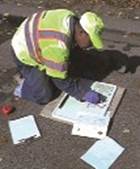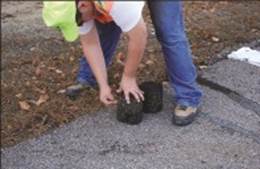U.S. Department of Transportation
Federal Highway Administration
1200 New Jersey Avenue, SE
Washington, DC 20590
202-366-4000
Federal Highway Administration Research and Technology
Coordinating, Developing, and Delivering Highway Transportation Innovations
| REPORT |
| This report is an archived publication and may contain dated technical, contact, and link information |
|
| Publication Number: FHWA-HRT-15-049 Date: April 2015 |
Publication Number: FHWA-HRT-15-049 Date: April 2015 |
 © SP-Photo/Shutterstock.com The LTPP processes and database can serve as a springboard to monitoring the long-term performance of new pavement materials and technologies in the future. |
The LTPP program was born in the 20th century, but it has already provided knowledge that is improving the design, construction, rehabilitation, and maintenance of pavements that are serving the 21st century. The performance data gathered in the LTPP experiments over the past quarter century, and data yet to be gathered from the program’s high-performing sections and new experiments, will provide insight into designing, constructing, and maintaining pavements that last long into the future.
More than 25 years after the LTPP program began, the benefits and products resulting from the program continue to advance pavement design and management worldwide. The LTPP database has played a critical role in the development and evaluation of every major pavement design methodology developed over the past two decades, including the 1998 American Association of State Highway and Transportation Officials (AASHTO) design procedures, Superpave®, and, most recently, the Mechanistic-Empirical Pavement Design Guide (MEPDG), implemented in the AASHTOWare® Pavement ME Design software. Beyond overall design procedures, the data have supported model development and validation for a wide array of pavement performance predictors and indicators. The program has also influenced industry practices and has raised the bar for data collection and laboratory analysis standards worldwide.
 © hxdyl/Shutterstock.com. "To learn the lessons required to design long-life, high-performance pavements, we must continue to track the performance of the more structurally robust test sections. It is their performance that will yield the requisite knowledge to develop, verify, and calibrate designs demanded by 21st century highway networks; their performance that will teach us how to manage and maintain these new pavements. If LTPP stops now, we will have only learned how to build and maintain 20th century pavements better." Transportation Research Board LTPP Committee, 20012 |
Although the LTPP program’s achievements have been many, to realize the full potential of the world’s most comprehensive pavement performance database and capitalize on the investment that has been made to date, much work remains to be done. As the national focus in transportation systems moves to performance standards and measures, as mandated by the Moving Ahead for Progress in the 21st Century Act (MAP-21),1 the program brings to the table data and data-related capabilities that are needed to support the understanding of pavement performance measures.
The program is committed to a fluid planning process with a 30-year horizon to keep pace with a changing world. Looking to the future, major areas of program activity will include the following:
The road ahead for the LTPP program continues to be a long one with these future activities paving the way.
The LTPP program has assembled massive amounts of information that are freely available to the pavement community (see sidebar). As described in chapter 8, researchers can now select and download LTPP performance data and ancillary information via the Internet and can request samples of paving materials from the Materials Reference Library. To maintain the usefulness of these resources to highway agencies and other pavement researchers, these assets must be properly secured, maintained, and upgraded with changing technology to assure continued access.
LTPP RESOURCES FOR DATA USERSThe LTPP program has assembled and made available two major bodies of electronic data, the Pavement Performance Database and an archive of information that supports the performance data known as AIMS–Ancillary Information Management System. In addition, the program maintains a huge and varied store of materials samples in the Materials Reference Library in Reno, Nevada. Together, the electronic data and physical specimens are a vital resource for future pavement research and are available through LTPP’s InfoPave™ Web site, where data can be downloaded, or by contacting the LTPP Customer Support Service Center (Email: ltppinfo@dot.gov).
|
The LTPP data have been available to all potential users since the first public release of data in 1991. These data will remain an important resource for pavement performance research for many years to come. Without adequate investment in security and maintenance activities, however, the potential of the LTPP database to contribute to advancements in pavement engineering could be gradually eroded and eventually lost altogether. Ensuring that the database and its supporting information remain accessible, yet secure, has required the program to take some important steps, which are outlined in chapter 8. The program will continue to maintain the security, functionality, and accessibility of the database and to upgrade the database software and hardware to keep pace with future changes in data storage, security, and communications needs and technologies.
Maintenance of the Materials Reference Library is also vital, as it is the repository for materials samples from the LTPP test sections and other pavement programs of national significance, and it also provides climate-controlled storage conditions for the LTPP 35-mm film distress records. Many of the materials samples are from projects with performance data, which makes the samples especially valuable to researchers. The samples have been used to support 32 national highway research projects. By continuing to maintain the Materials Reference Library, the LTPP program will enable researchers to link the results of past, present, and future pavement research. Researchers will be able to use samples from the test sections, for example, in evaluating future test methods, thereby enabling updates of the data to reflect new technologies.
Refining and improving the LTPP database so that it is aligned with users’needs is critical to achieving the full future value of the LTPP program. Additional refinement of the database will make it easier and more effective to use. Several planned database improvements, many of which are currently underway, have the potential to accomplish this goal:
Given the complexity of the LTPP database, continuing to provide technical support to data users will be crucial to maximizing research results. Researchers around the world have successfully used the data to address an array of pavement engineering challenges. Vital to this success has been the availability of LTPP technical support to answer questions, point researchers to the documentation they need to understand the data applicable to their problems, and otherwise help users navigate and manipulate the database structure to select the appropriate data.
Future user support will take different forms, depending on the intended use of the data. The LTPP program’s primary customer, highway agencies using the LTPP database to address pavement issues of concern to them, will receive support to ensure clear understanding of the data being provided and to assist them with any problems. Such support may focus on generating data sets for selected locations that could be used to calibrate the MEPDG for a State or Province’s local conditions. In the future, when national pavement performance measures are established, the LTPP database is likely to be the prime resource for highway agencies’use.
For studies of national significance, such as the National Cooperative Highway Research Program (NCHRP) project that developed the MEPDG, support will often entail face-to-face meetings to communicate fully the data needs and required formats and to identify the best source of the data within the LTPP database. Custom extractions from the database can then be performed to provide the needed data in the appropriate format, followed by ongoing technical support to ensure clear understanding of the LTPP data and to clarify any issues that may arise.
Support will also include training for Federal, State/Province, and local agencies, as well as members of industry and academia. For example, the LTPP program has developed a workshop to familiarize pavement engineering professors with the database and engage them in using the data to solve real-world pavement analysis problems. For university students working on theses, dissertations, or other research projects, support will include providing them with the latest LTPP Standard Data Release, recommendations on where to find the needed data within the database structure, and clarification of data-related questions.
The LTPP program’s pavement performance data collection effort is the largest and most comprehensive ever undertaken for in-service highway pavements. The program has monitored 2,509 test sections located throughout the United States and Canada. The test sections that are still being monitored include many that are part of the program’s rehabilitation and structural factor experiments; long-life, high-performance pavements; and sites where traffic monitoring continues.
Changes in technology will also expand the types and quantity of performance-related data that can be captured. For example, variations in the quality of construction have a vital impact on pavement performance. As technologies evolve, new tools are becoming available to capture more comprehensive data during construction, enabling highway agencies to know whether pavements are built as planned. Some examples of these technologies are magnetic tomography systems for checking dowel bar alignment5 and full-width infrared thermography scanning systems for measuring HMA placement temperatures in real time.6 With additional information that these technologies can provide, “noise” in the data may be reduced and clear trends may appear. As it pursues new experiments, the LTPP program will be examining technologies that can help to identify and separate the many variables affecting pavement performance.
LTPP data yet to be collected will contribute valuable new information to pavement performance research. The future of LTPP data collection will include completion of the original experiments, forensic studies of selected test sections that can shed light on specific performance questions, and new experiments designed around emerging technologies, such as warm-mix asphalt (WMA) and pavement preservation.
As of 2014, 732 of the original LTPP test sections were still being monitored—372 in the General Pavement Study (GPS) experiments, and 360 in the Specific Pavement Study (SPS) experiments. To achieve the objectives for each experiment, it is critical that data be collected for the remaining sections over a full performance cycle, especially in view of the shortage of test sections in some experiments when the designs were implemented.
Some of these active test sections have been constructed or rehabilitated within the past decade, some are long-life sections still in good condition, and others have been monitored as LTPP test sections both before and after rehabilitation. Traffic data also continue to be collected on most SPS test sections. Many GPS and SPS sections whose performance cycle monitoring has been completed have been moved to the GPS-6 (asphalt concrete (AC) overlay of AC pavements) and -7 (AC overlay of PCC pavements) experiments. Some of the experiments were designed to complement each other, for example, GPS-1 and -2 (AC on granular and bound base pavements, respectively) and SPS-1 (structural factors for flexible pavements). GPS-9 (unbonded PCC overlay of PCC pavements) represents the only available long-term data on composite pavement structures and has been given priority due to a request from the Strategic Highway Research Program (SHRP) 2. The LTPP program will continue monitoring these sections to fully answer the critical pavement performance questions they were designed to address.
One future opportunity that merits consideration is to collect permanent distress records for those test sections that remain in service, as recommended by the Transportation Research Board (TRB) LTPP Committee. Table 12.1 outlines the benefits of monitoring active test sections throughout their performance lives.
| LTPP Experiment | Benefits of Additional Data Collection |
|---|---|
| SPS-1 (structural factors for flexible pavements) SPS-2 (structural factors for rigid pavements) |
Improved ability to derive definitive results, based on complete performance histories, concerning the impact of design features on long-term pavement performance. |
| SPS-8 (environmental effects in the absence of heavy loads) | Assessment of the effects of loading and environment on pavement life, information that is critical for pavement design and performance models. This work can begin when sufficient distress (serviceability loss) has accumulated on the SPS-8 test sections. |
| GPS-6 (AC overlay of AC pavements) GPS-7 (AC overlay of PCC pavements) SPS-5 (rehabilitation of AC pavements) SPS-6 (rehabilitation of jointed PCC pavements) SPS-9 (Superpave®) |
Improved design, construction, and maintenance procedures for asphalt concrete overlays, which will result in longer and more economical renewed pavement life. |
| GPS-1 (AC on granular base pavements) GPS-2 (AC on bound base pavements) GPS-3 (jointed plain concrete pavements) GPS-4 (jointed reinforced concrete pavements) GPS-5 (continuously reinforced concrete pavements) GPS-9 (unbonded PCC overlay of PCC pavements) |
Performance data required to develop, verify, and calibrate designs for long-life, high-performance pavements and to manage and maintain those new pavements. |
| Permanent distress records (photographs) for still-active test sections | Future analysts will have the opportunity to revisit test section condition on the basis of objective records. Potential for interpretation/reinterpretation of images based on improved distress definitions and criteria. |
| Note. Adapted from LTPP Beyond FY 2009: What Needs to Be Done?, p. 12.7 | |
Another significant source of data for the program are forensic studies at selected LTPP test sections when they are removed from the study. Close examination of these mature sections before they are replaced or rehabilitated can yield new data and analyses that will contribute much to the understanding of pavement deterioration processes.8 Although forensic evaluations are an important element in the LTPP program, funding constraints delayed implementation. As described in chapter 7, the program published the Framework for LTPP Forensic Investigations in 2004 and conducted four forensic studies, funded by the Federal Highway Administration (FHWA), in 2008. Several highway agencies have also conducted forensic evaluations of LTPP test sections.
Forensic investigation of LTPP test sections that have failed prematurely and sections that have shown unexpectedly good performance are of particular value in understanding the variables that affect pavement performance. With national guidelines in place, the foundation has been laid for future forensic investigations of LTPP test sections as well as other pavement studies by highway agencies.
Alongside the continued monitoring in the original LTPP experiments to achieve the program’s original objectives, the program’s leaders and advisors recognize that new technologies have been introduced and implemented since the program was planned in the mid-1980s. Some examples are Superpave, the MEPDG, in-place recycling, and alternative construction materials such as aggregates from waste sources, composite materials, precast concrete pavements, and nano particles. In addition, the impact of climate on infrastructure is of increasing importance. The LTPP program is addressing these changing needs in its short- and long-range plans.
In the near term, the foundation has been set for a new LTPP field experiment to collect short-term and long-term research-grade performance data on WMA pavements. With support from FHWA management and as part of a multiteam effort, this experiment is designed to determine whether there is any significant difference between the performance of WMA and that of HMA. The FHWA is partnering with States and Provinces to construct projects in support of this national experiment. Test section recruitment and selection for the new SPS-10 experiment, Warm-Mix Asphalt Overlay of Asphalt Pavements, began in 2014, with construction slated for 2014 and 2015.9
The LTPP WMA experiment will be followed by other new field experiments in the years to come. There is, for example, a real need today to understand pavement preservation and its impact on pavement performance. Planning is underway for a pavement preservation experiment. Planning activities for a cold- in-place recycling experiment will follow next, and other current topics of interest—hot-in-place recycling, composite pavements, precast pavements, and fast-track pavement construction—are being considered. As technologies evolve and are implemented in the field under real conditions, the need to perform long-term monitoring will continue.
 |
 |
 |
 |
Data analysis and product development have been integral to the LTPP program from its early days. Focused analysis has led to many program improvements in data collection practices and interpretation over the years and revealed the need for new software and engineering tools to improve the uniformity and validity of the data being collected. Data analysis and product development will take on even greater importance in the future with the maturity of data collection and the database itself.
Analysis of LTPP data began in 1992 with the evaluation of the then-current version of the AASHTO Guide for the Design of Pavement Structures. That analysis showed large discrepancies between predicted and actual pavement performance, confirming the need for a new design guide. More recently, LTPP data and data analyses were critical in the development of the MEPDG under NCHRP Project 1-37A. LTPP data analysis reports have been published by SHRP, FHWA, and NCHRP. States, Provinces, and universities have also published hundreds of reports, theses, and dissertations based on the analysis of LTPP data.
FHWA worked with the TRB Expert Task Group on LTPP Data Analysis to develop the Strategic Plan for LTPP Data Analysis in 1999, as described in chapter 10.10 The plan, which has been expanded and maintained with the support of the TRB LTPP Committee, presents a long-term strategy for data analysis that takes into account both internal and external analytical needs, the current or anticipated data availability, and the process for developing major LTPP products. It may be useful to repeat here the current plan’s nine strategic objective areas:
By 2014, under the plan, 76 studies had been completed, 18 studies were ongoing, and 13 were planned. An additional 104 problem statements on the plan awaited funding. In addition, the program recommends that early findings from LTPP data be re-examined to determine if the short-term trends were correct. The LTPP program will support continued data analysis that is aligned with the objectives outlined in the plan.
The greatest benefit from the LTPP database will be realized by applying the data and then developing products from what is learned through this application. To achieve the most immediate impact and capture the full value of the data, a coordinated and integrated approach to analysis will be accompanied by a similarly coordinated product development program.
Products resulting from the LTPP data have benefited highway agencies and other segments of the highway community. These products include new methods, guidelines, and procedures for standardized pavement testing and performance data collection. As more pavement performance data are added to the database from the original and new experiments, and if highway legislations continue to be driven by performance and asset management imperatives, the LTPP program will remain in the forefront of providing the data, resources, and technical expertise needed to develop future products for highway agencies and the pavement industry. What these new products will be is still to be determined.
Other significant products of the LTPP program will continue to be issued. The Standard Data Releases are available via the Internet at LTPP’s InfoPave™ Web site, so that users can easily access the wealth of information available in the LTPP database. The program’s guidelines for data collection and distress rating, such as the Distress Identification Manual, will be updated as needed.
Another benefit that will continue into the future is the introduction and use of LTPP data in university engineering curricula. This curricula application will introduce both professors and students to the use of database manipulation tools, which is a necessary skill that is not currently covered in most engineering programs. As in the past, future undergraduate and graduate students will use the LTPP database and monitoring procedures as part of their pavement engineering coursework. Many students will be introduced to the database and to pavement research through the ASCE-LTPP International Data Analysis Contest.
Long-term monitoring of pavement performance continues to be a key need nationwide, just as it was in the 1980s when the LTPP program began. The LTPP processes and database can serve as a springboard to monitoring the long-term performance of new pavement materials and technologies in the future.
The LTPP program has created many products to date, but the most significant products are yet to come, after the full performance history of the test sections has been documented and complete suites of quality data are available in the LTPP database.
With regard to its ultimate potential, the LTPP program has barely started to advance the knowledge of researchers and practitioners—yet it already has contributed to saving billions of dollars in construction and maintenance costs.12 Pavement engineers and designers will rely on the LTPP database, a kind of “virtual highway” to improved pavement performance, for decades to come.
Although it is not possible to envision every possible future use and insight, the larger the pool of analysts using LTPP data and other ancillary information, the greater the chances are that the data will support major breakthroughs. Some of the resources that future users may investigate to gain better insight into pavement performance include the following:
In addition, the international community will look to the LTPP program in establishing their own long-term research programs (most recently, Brazil has requested several FHWA visits to discuss how such a program can be implemented there), and other domestic programs, such as the Long-Term Bridge Performance Program, will benefit from LTPP’s models of data quality standards and coordination necessary to successfully meet their objectives.
The LTPP program is one of several programs and initiatives that collect or use highway data in planning and policymaking related to different aspects of the Nation’s transportation systems. For example, data from the LTPP program complement the data of the Highway Performance Monitoring System, which is used in highway policymaking. The LTPP program is in a position to share knowledge, data, and research facilities with other highway data collection initiatives to assure the availability, reliability, and validity of data used for research into pavement performance measures. Collaboration at this level can maximize budgetary resources and assure that the data secured are of the highest quality possible. The LTPP program will continue working with the highway agencies, AASHTO, and TRB to provide research-quality data that meets the present and future needs of the pavement community.
The LTPP database has enormous potential as the foundation for improvement in pavement engineering and management procedures and practices. Some of that potential has already been realized, but additional work will be required to take full advantage of the investment made in the program.
For the LTPP program, the road ahead is one of opportunity. By continuing to invest in the database and the Materials Reference Library and by continuing to collect data, conduct data analyses, and develop products, the program will carry forward benefits and rewards for a new generation of highway engineers and researchers facing new challenges. Building on the lessons learned to date is also vital to achieving the program’s full potential. While much has been accomplished, the LTPP data still offer the key to even better performing pavements tomorrow. Even as the LTPP data and products change today’s pavement design and management worldwide, the LTPP story continues, and the best is yet to be discovered.